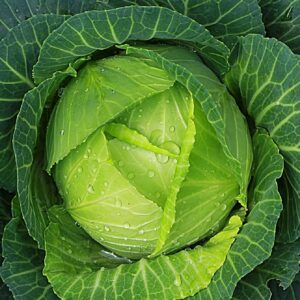Grow Cabbage Without Watering: Low-Maintenance Tips for a Thriving Harvest

As a busy gardener or someone living in a dry climate, the prospect of growing cabbage can seem daunting. The traditional methods often require constant watering and intensive care, which can be a real challenge to fit into a hectic schedule. However, with the right techniques, it’s entirely possible to cultivate healthy, delicious cabbage without the need for frequent watering or high-maintenance practices. In this comprehensive guide, we’ll explore the secrets to growing cabbage with minimal effort, so you can enjoy a bountiful harvest while saving time and resources.
Understanding the Water Needs of Cabbage

Cabbage is a cool-weather crop that typically requires consistent moisture to thrive. In their natural growing conditions, cabbages would receive regular rainfall to keep the soil consistently moist. However, in many modern gardens and climates, this level of natural precipitation is not always available. This is where the low-water growing techniques come into play.
The key to growing cabbage without frequent watering is to focus on building a healthy, moisture-retentive soil. By amending the soil with organic matter and using mulch, you can create an environment that allows the cabbage plants to access the water they need, even during dry spells. Additionally, selecting drought-tolerant cabbage varieties and implementing strategic planting techniques can further reduce the water requirements of your crop.
Preparing the Soil for Low-Water Cabbage Growing
One of the most important steps in growing cabbage without constant watering is to ensure your soil is well-prepared and optimized for moisture retention. Here are some tips to get your soil ready for low-maintenance cabbage cultivation:
- Incorporate Organic Matter: Adding generous amounts of compost, well-rotted manure, or other organic matter to your soil will help improve its water-holding capacity. These materials act like sponges, absorbing and slowly releasing moisture to the plant roots.
- Adjust Soil pH: Cabbages thrive in slightly acidic soil, with a pH between 6.0 and 7.5. Test your soil and amend it with lime or sulfur as needed to achieve the optimal pH range.
- Improve Drainage: While cabbages prefer moist soil, they cannot tolerate waterlogged conditions. Ensure your planting area has good drainage by incorporating sand, perlite, or other amendments to prevent soil compaction and standing water.
- Mulch the Soil Surface: Applying a 2-4 inch layer of organic mulch, such as wood chips, straw, or leaves, will help retain moisture in the soil and suppress weed growth, further reducing the need for watering.
By taking the time to properly prepare your soil, you’ll create an ideal environment for your cabbage plants to thrive with minimal water requirements.
Selecting Drought-Tolerant Cabbage Varieties
Not all cabbage varieties are created equal when it comes to water needs. Some cultivars are naturally more drought-tolerant than others, making them a better choice for low-maintenance gardening. When selecting your cabbage seeds or seedlings, look for varieties that are specifically marketed as being suitable for dry conditions or water-wise gardening. Some examples of drought-resistant cabbage varieties include:
- Stonehead: A compact, round-headed cabbage that is known for its ability to withstand heat and drought conditions.
- Savoy Ace: This savoy-type cabbage has a crinkled, textured leaf that helps it retain moisture more effectively than smooth-leaved varieties.
- Deadon: A red cabbage cultivar that is particularly hardy and can tolerate drier soil conditions better than many green cabbage types.
- Caraflex: A pointed, conical-shaped cabbage that is well-suited for growing in hot, dry climates.
By selecting drought-tolerant cabbage varieties, you’ll be giving your plants a head start in thriving with minimal water input.
Planting Techniques for Low-Water Cabbage
In addition to preparing the soil and choosing the right cabbage cultivars, the way you plant your cabbages can also play a significant role in reducing their water needs. Here are some strategic planting techniques to consider:
Raised Beds
Planting your cabbages in raised beds can be a game-changer for low-water gardening. Raised beds improve drainage, allowing excess moisture to quickly move away from the plant roots. They also encourage deeper root growth, which helps the plants access water from deeper in the soil profile. Additionally, the increased soil volume in a raised bed provides more space for organic matter incorporation, further enhancing moisture retention.
Spacing and Shading
Proper spacing between your cabbage plants is crucial for reducing water needs. Overcrowding can lead to increased competition for limited moisture, so be sure to follow the recommended spacing guidelines for your specific cabbage variety. Additionally, consider planting taller, shade-producing crops, such as corn or sunflowers, around the perimeter of your cabbage patch. This can help provide some natural shading, which can reduce evaporation and keep the soil cooler and more moist.
Mulching and Water-Saving Techniques
As mentioned earlier, applying a thick layer of organic mulch around your cabbage plants is an excellent way to conserve soil moisture. Additionally, you can explore other water-saving techniques, such as using drip irrigation or soaker hoses, which deliver water directly to the root zone and minimize evaporation. These methods can be particularly helpful during periods of extended drought or heat.
Ongoing Care and Maintenance
Once your cabbage plants are established, there are a few key maintenance practices you can implement to ensure they continue to thrive with minimal water input:
Monitoring Soil Moisture
Regularly check the soil moisture around your cabbage plants, either by sticking your finger into the soil or using a moisture meter. If the soil begins to dry out, provide a deep, thorough watering to saturate the root zone. Avoid frequent, shallow watering, as this can encourage shallow root growth and make the plants more susceptible to drought stress.
Supplemental Watering During Dry Spells
Even with all the water-saving techniques in place, your cabbage plants may still require some supplemental watering during extended periods of drought or heat. When this happens, focus on providing deep, infrequent waterings rather than frequent, light sprinklings. This will encourage the roots to grow deeper, allowing the plants to better access moisture from the soil.
Pest and Disease Management
Maintaining the overall health and vigor of your cabbage plants is crucial for their ability to withstand dry conditions. Be vigilant in monitoring for and addressing any pest or disease issues that may arise, as stressed plants are more susceptible to these problems. Utilize organic pest control methods and promote beneficial insects to help keep your cabbage patch thriving.
Maximizing Your Cabbage Harvest
By following the low-water growing techniques outlined in this guide, you’ll be well on your way to cultivating a bountiful cabbage harvest with minimal effort. To further optimize your yields, consider these additional tips:
- Succession Planting: Sow cabbage seeds or transplant seedlings at staggered intervals throughout the growing season to extend your harvest period.
- Intercropping: Grow complementary crops, such as radishes or lettuce, alongside your cabbage plants to maximize the use of available space and resources.
- Proper Harvesting: Harvest your cabbage heads at the optimal maturity, typically when they are firm and fully developed. Leaving them in the ground too long can lead to splitting or bolting.
- Storage and Preservation: Explore methods for storing and preserving your cabbage harvest, such as pickling, fermenting, or freezing, to extend the enjoyment of your low-maintenance crop.
By combining the water-saving techniques outlined in this guide with smart growing and harvesting practices, you’ll be able to enjoy a thriving, low-maintenance cabbage patch that provides a bountiful and delicious harvest, even in dry conditions.



